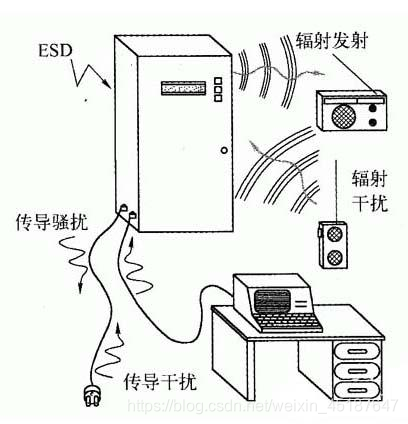EMC (Electro MagneTIc CompaTIbility) - Electromagnetic compatibility is the ability of electrical and electronic equipment or systems in the expected electromagnetic environment, according to the design work, as well as electronic, electrical or set up a system of various important technical performance. On a global scale, the electromagnetic compatibility issues have formed a new discipline, but also an electromagnetic field theory, including disciplinary information, electrical, electronics, communications, materials, structures such as the edge of science, but also a practice relatively strong discipline that requires product engineers have a wealth of practical knowledge. When EMC central subject is the study of how to control and eliminate electromagnetic interference, electronic devices or systems work together with other devices, it does not lead to performance of any part of the device or system deterioration or reduced. A design ideal electronic device or system should neither emit any unwanted energy, but also do not want to be free from any influence some energy. Of course, before the electronic device or system factory, the main measure in accordance with its EMC J SUI is good or bad FMC test results. These tests, a number of analog products is harassment and interference occurring in the actual work environment, as illustrated in FIG. At present, the measure of a product's EMC brief can mainly be considered from the following two aspects.

Some of harassment and interference products occur in the actual work environment
(1) EMI (Electro MagneTIc Interference) - electromagnetic interference. I.e., in certain circumstances a device or system during normal operation, should not exceed the standard generating electromagnetic energy in the desired interference. Such electromagnetic interference are:
● out conducting electromagnetic disturbances from the power line;
● conducting out from the signal line, a control line harassment;
● radiated from the housing products (including all cables products) out of harassment;
● conducted from the power port out harmonic currents (Harmonic);
● voltage fluctuations and flicker generated power port (FluctuaTIon and Flicker).
(2) EMS (Electro MagneTIc Susceptibility) - electromagnetic immunity performance. I.e., in a certain environment or provided for each system during normal operation, each set or the system can withstand all types of electromagnetic energy interference. This electromagnetic energy interference are:
● Electrostatic discharge;
● power supply port of EFT;
● a signal line control circuit EFT antenna port;
● lightning surge and power port;
● a signal line, and a lightning surge control line ports;
● electromagnetic radiation to pass from the space housing the product;
● incoming power port conduction disturbances;
● power supply voltage drop ports and interrupts.
EMC design is in the product design process, design techniques and the use of certain additional technical means to improve the performance of EMC products (including anti-harassment and anti-jamming capability level products product), and can in certain circumstances in accordance with the design of the product expected normal operation. To measure performance to reach the EMC product before the actual application environment, you need to perform EMC testing. FMC corresponds to the product of the above indicators, EMC test usually have the following two aspects.
(1) EMI electromagnetic interference testing
● power line conducted disturbances (CE) test;
● signal, the control line conduction disturbance (CE) test;
● radiation disturbance (RE) of the test;
● harmonic current (Harmonic) chant Dao sample;
● voltage fluctuations and flicker (Fluctuation and Flicker) test.
(2) EMS electromagnetic immunity test
● Electrostatic discharge (ESD) immunity test;
● power source EFT (EFT / B) immunity test port;
● a signal line, a control line electrically EFT (EFT / B) immunity test;
● a power surge (SURGE) and lightning test port;
● a signal line, a control line surge (SURGE) and lightning test;
● radiation immunity housing (RS) K. Dao dam;
● power conduction immunity (CS) test port;
● a signal line, a control line conducted immunity (CS) test;
● voltage drop and break test (DIP) power port.
For the automotive and automotive electronic equipment, due to its electromagnetic environment and the environment is relatively special power supply, EMC test its relatively special, but also can be divided into EMI testing and EMS test two categories. It is more highlight the importance of ISO, CISPR and SAEJ standards, specific FMC test project has two.
(1) EMI test
● compliance CISPR25 (corresponds to GB GB18655), CISPR12 (corresponds to GB GB14023), SAEJ551 / 5 (corresponding to GB is GB18387) Emission Test standard;
● compliance CISPR25 (corresponds to GB GB18655) standard conductive coupling / emission transient emission test.
(2) EMS test
● meet 1507637-1 / 2 standard power cord conductive coupling / transient immunity test;
● sensor cables and control cables meet predetermined criteria 1507637-3 conductive coupling / transient immunity test;
● meet 150114527 (corresponding to GB GB17619) Conducted RF immunity test specified in the standard;
● According to 15011452-2 (corresponding to GB for the GB17619) radiation field immunity test standards prescribed;
● meet 15011452-3 (corresponding to GB GB17619) of a predetermined standard transverse electromagnetic (TEM) radiation immunity test small chamber;
● According to 15011452-4 (corresponding to GB for the GB17619) specified in the standard high current injection (BCI) immunity test;
● meet 15011452-5 (corresponding to GB GB17619) stripline immunity test specified in the standard;
● meet 15011452-6 (corresponding labeled halide GB17619) triplate immunity test specified in the standard;
● Electrostatic discharge immunity in line with 15,010,605 standard test.
EMC can not be designed as hardware design, structural design, software design and other design activities can stand alone, it is dependent on other design activities products. If you must be on the EMC design activities are classified, so include:
(1) EMC standards and product requirements analysis;
(2) the product of FMC mechanical structural frame design, including the design of the cable part of the product;
(3) a circuit schematic design FMC;
(4) PCB EMC design;
(5) EMC testing process improvement problem.
more content